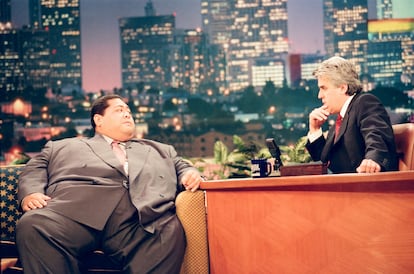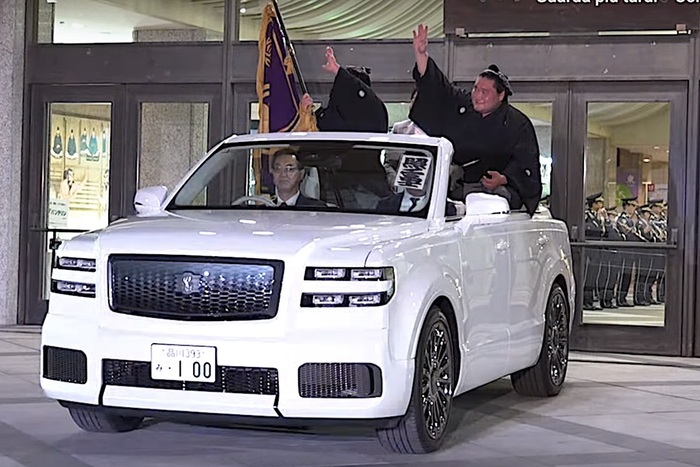The image is known to almost everyone: two plump, half-naked guys, in what look like diapers, push each other freehand and maybe give each other the odd snooze until they knock the adversary to the ground or take him out of the fighting circle. However, few know much more in the West about sumo, which is often viewed in a cartoonish way and as a source of laughter or ridicule, given the extraordinary scale of the wrestlers. Quite the opposite of what happens in Japan, where combatants are considered imbued with a semi-divine aura. In fact, it is part of the founding myth of the country: according to the
Kojiki
(712 AD), the oldest surviving Japanese book, the islands of Japan were conquered thousands of years ago by the gods of the sky with a sumo fight.
“Every time her grandmother sees a sumo wrestler, she hands the girl over to him saying, 'Please take this baby!'
She has already been rocked four times and thanks to that she is growing up in very good health ”, says a Japanese mother in the series
Gigantes: Las leyendas del sumo de Hawaii
, Rakuten TV's own production that the platform premieres on July 22 all over the world. world.
The documentary, which has three half-hour episodes, explores the landing in Japan of the Hawaiian stars Konishiki, Musashimaru, Takamiyama and Akebono, when no foreigner had yet achieved the rank of great champion (
yokozuna
).
In addition to looking back at their integration into such a local and hermetic ecosystem or their trajectories, the series stops at the chiaroscuro of this particular sport.
Inevitably, one of the key issues is the weight and diet of the fighters. At one point in the documentary, Konishiki's wife talks about how the size of the athlete interfered in her life and remembers, for example, a date in a restaurant that ended with the
sumotori
[the sumo wrestler] trapped in the bathroom and the waiters having to remove the door to allow his exit. Konishiki, who weighed 287 kilos, narrates that as a fighter he had to consume between 6,000 and 8,000 calories each time he sat at the table, which, in two daily meals, amounted to between 12,000 and 16,000 calories per day. "If you are not a person with an appetite, you will have no choice but to develop it when entering the world of sumo," he warns. A dietitian acknowledges that, although sumos nutrition is "enormously rich in vitamins and minerals" due to the variety of meats, fish, cereals and vegetables it includes, their massive intake obviously represents a problem. "Being forced to eat can be emotionally very stressful," he says.
Big and well dressed: A Sumo wrestler walks out of a Chanel boutique in Paris in 1995.Bernard Bisson / Sygma via Getty Images
Sumo fighters are estimated to have a life expectancy of between 60 and 65 years, 20 below the Japanese average, which is one of the highest in the world.
Eduardo de Paz, a Spanish expert in this sport and a Eurosport commentator, explains to ICON: “There are many wrestlers who have diabetes problems, it is the most common in sumo.
In addition, the food they eat, called
chanko-nabe
[collective pot made up, according to the documentary, of 90 kilos of meat and 45 of vegetables], a kind of wild stew where absolutely everything fits, is watered with a lot of alcohol ”.
De Paz is the author of one of the few books in Castilian on the subject,
Sumo, the struggle of the gods
(Shinden Ediciones, 2006).
In it, he details that the conditions to enter professional sumo are not really demanding: the minimum height and weight requirements are, respectively, 170 centimeters and 75 kilos.
“They are lax, because if they asked for bigger people, they wouldn't find them.
What's more, if you go to a lower category tournament, you see very thin fighters, kids like the ones you can find on the street.
Then the
heyas
[residences where the sumos live and practice] are in charge of fattening them so that they grow and get fat, ”says De Paz.
In his book, the author qualifies as "feudal" the lifestyle of the fighters within these
heyas
, as it is governed by an absolutely hierarchical structure dominated by the owner, which is the
oyakata.
[or head coach], tight schedules and little freedom of movement. Although the wrestlers do have their own mobile phone, recently the Japanese Sumo Association prohibited them from having social networks. “They are still boys in their twenties or early twenties, they like to share things and write jokes. As happens so many times, some of them were a bit risque and they were restricted ”, the expert tells ICON.
Only the fighters of the two main categories receive a salary, while those of lower rank live practically disenfranchised. For example, they are in charge of the kitchen or cleaning tasks in the residences. The treatment they receive can also be very harsh: in
Gigantes
, without going any further, you can see images of the
oyakata
Takasago strongly attacking one of his athletes with a cane, who does not oppose a reaction. Especially notorious was the case of the minor Takashi Saito, 17, who died in 2008 as a result of the brutal beating received by his coach (who was sentenced to six years in prison for these events) and three apprentices, whom he ordered to hit in retaliation for wanting to leave the
heya
.
Likewise, not many
sumotori
manage to remain linked to the sport when their career ends, due to the limitations that exist to obtain the title of coach or to be part of the Sumo Association, with only 105 places. “For many, the return to the real world is very hard, because they have not done anything else in their life. Maybe they are 35 or 38 years old, without studies or with very basic studies because they were abandoned very young to enter the heya, and they go out into the labor market without knowing how to do anything other than fight, "explains Eduardo de Paz to ICON. Some end up dedicating themselves to show business. The Hawaiian Konishiki, who was close to being the first
yokozuna
foreigner but never promoted, he dissociated himself from sumo and began a career in rap, with hits such as
Sumo gangsta
or
Sumo stomp
. He has also participated in some films; among others, he appeared briefly in
Full throttle: Tokyo Race
.
Despite the thorny issues that concern this sport, immobility is a hallmark of the Japan Sumo Association. “Whenever something happens, they say: 'We are going to study it,' or: 'We are going to create a commission to deal with this issue.' They let it pass until they talk about it and then they no longer see the need to create any commission, ”continues Eduardo de Paz. The most recent controversy in which sumo has been involved was the order, over the loudspeaker and shouts by some members of the public, to two women to leave the
dohyo
[platform where the fights are held] after they went up to revive a politician who had fainted: according to Shinto, the religion that governs this fight, menstruation is impure, so that no person with a uterus can step on sacred ground, as it is considered to that space. “In the nineties, in Osaka, there was a governor who was not allowed to go up to deliver the trophy for the region. Instead, the lieutenant governor had to do it. Then there was talk of changing it, but everything remains the same and I have no doubt that it will continue like this for many years, ”says De Paz.
Nor is the debate on the table to reduce the diets of wrestlers to avoid health problems, nor is there work to expand the popularity of the sport outside the Japanese borders. Efforts to organize international championships have come from the
amateur
sphere
, where it is possible to participate regardless of sex, since the fights are not held in blessed places. The accusations of racism and xenophobia, intensified in the early nineties, when Konishiki was not promoted to the rank of
yokozuna
, have been overcome.
: Once fellow Hawaiian Akebono reached the title in 1993 and became the first foreigner to do so, the doors of sumo opened for more non-Japanese-born fighters, who are currently dominating the main categories.
Jay Leno interviews professional sumo wrestler Konishiki Yasokichi in 1998.NBC / NBCU Photo Bank / NBCUniversal via
Despite the loss of momentum from the Japanese, sumo remains a deeply entrenched phenomenon in the country. The prices for an evening do not make it as inaccessible to the general public as other sports, with the cheapest seats costing between 20 and 30 euros. The commentator and expert Eduardo de Paz, who in his book tells how as a young man he fell in love with sumo due to its "plastic beauty", in addition to calling it "art", highlights to ICON that its connection with Shintoism makes it even more important to the population. "Seeing them pour all those amounts of rice brightens my day, I really believe that you can receive powers from them," he says in the documentary
Gigantes
an old Japanese man, interviewed near a heya.
Also in the series, journalist David E. Sanger, who was a correspondent for
The New York Times
in Tokyo, admits that the rituals around the fights are sometimes more beautiful to watch than the fights themselves, which tend to last less. one minute.
And what are those rituals like?
On the
dohyo,
purified the day before, two wrestlers stand after their names are chanted.
They lift one leg and drop it, hard, on the ground.
Afterwards, they rinse their mouths with water offered in a saucepan by the winner of the previous fight, so that he transmits his strength to them.
They then take a handful of salt, throw it in to purify the
dohyo
again
and they stand in front of their rival to make him see, with open palms, that they are not hiding any weapons and will not fight with anything other than their flesh.
They proceed to stare at each other, put their fists on the ground, return for another handful of rice to throw it away, look at each other and, finally, the combat arrives, the climax of a national rite that is half sport, half religious ceremony, but not It has a point of comparison with what we understand here by sports and, far from it, religious ceremonies.
You can follow ICON on
,
,
, or subscribe here to the
Newsletter
.







